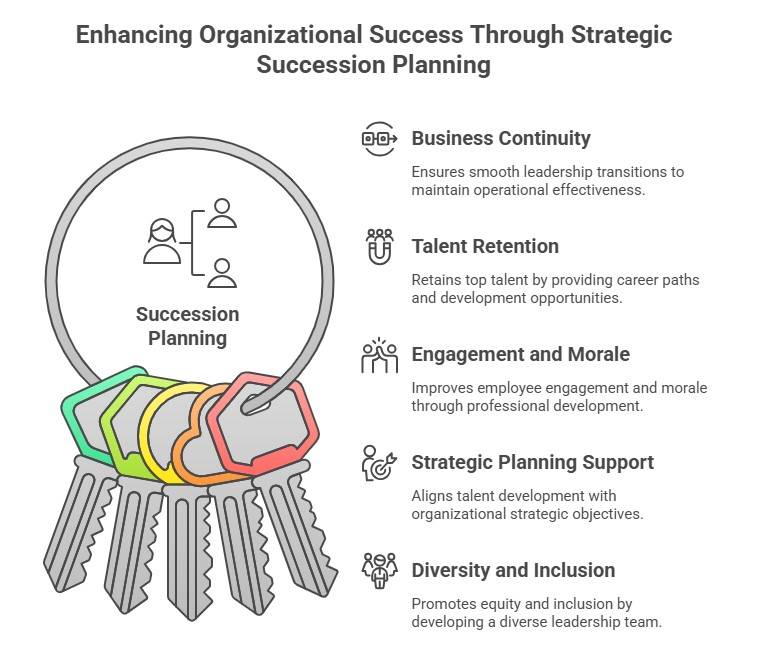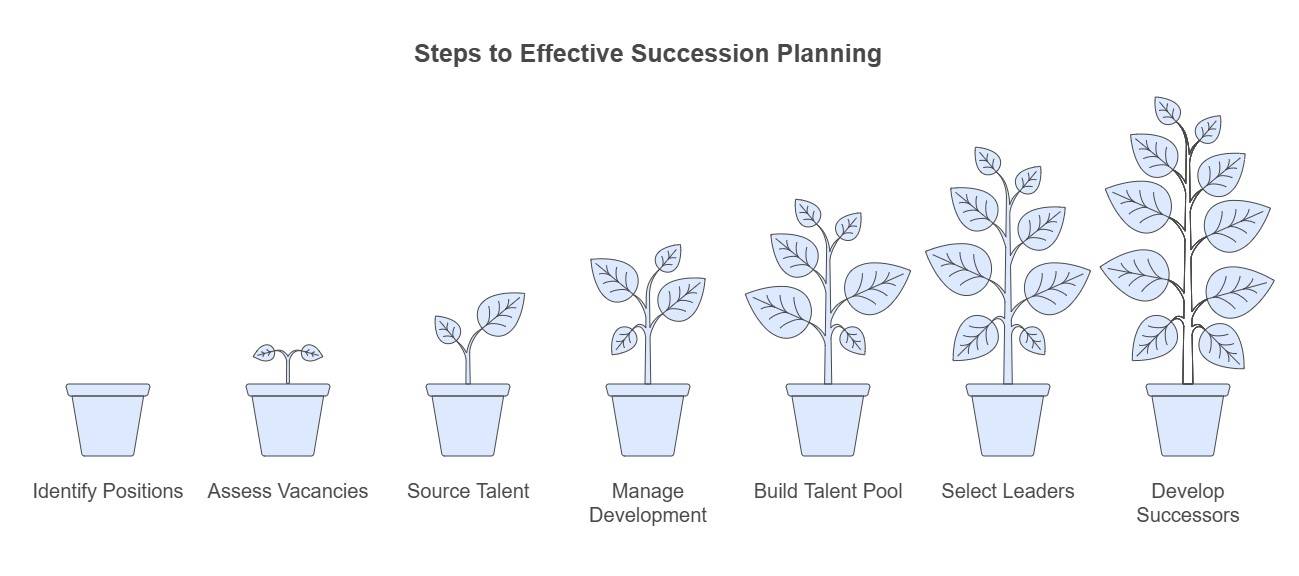Succession Planning in HRM: Meaning and Process
Succession planning in HRM ensures business continuity by preparing future leaders. HR identifies key roles, assesses talent, and develops potential successors. Beyond planning, it involves mentoring, skill-building, and aligning employee growth with company goals. This proactive approach reduces risks, supports smooth transitions, and strengthens long-term organizational stability.
Imagine a thriving company, XYZ Corp, led by a visionary CEO who has steered it to great success. As the CEO approaches retirement, the company needs to find a new leader to take over. Succession planning involves identifying and training employees to fill critical roles. With the help of online HRM courses and certifications, HR teams are better equipped to manage this transition. By having a plan, XYZ ensures business continuity, talent retention, and a competitive edge. It’s like having a well-trained co-pilot ready to take over the controls, ensuring the organization's journey continues seamlessly.
Table of Content
Definition of Succession Planning
Succession planning is the strategic process of identifying and developing internal candidates to fill key organizational roles. It creates a talent pipeline of successors by ensuring business continuity and leadership in the face of role transitions, departures, or unforeseen events. Effective succession planning aligns with the organization's strategic vision and prepares future leaders to drive it forward.
Best-suited Human Resources courses for you
Learn Human Resources with these high-rated online courses
Importance of Succession Planning
Succession planning is essential for ensuring business continuity and long-term growth. It prepares organizations to seamlessly fill key roles, minimizing disruptions and safeguarding leadership stability during transitions.
Business Continuity
Succession planning ensures smooth leadership transitions by identifying and developing internal candidates to fill critical roles. This minimizes disruptions and maintains operational effectiveness, allowing the organization to continue pursuing its strategic objectives without interruption during times of change.
Talent Retention
By providing clear career paths and development opportunities, succession planning helps retain top talent. Employees are more likely to stay with an organization that invests in their growth and offers opportunities for advancement. This reduces turnover costs and maintains institutional knowledge.
Engagement and Morale
Succession planning demonstrates an organization's commitment to its employees' professional development. When employees see a clear path for growth and feel valued, engagement and morale improve, which can positively impact productivity, performance, and job satisfaction.
Strategic Planning Support
Effective succession planning aligns talent development with the organization's strategic objectives. By identifying the skills and competencies needed for future success, organisations can proactively develop a pipeline of leaders ready to drive the company's long-term goals.
Diversity, Equity, and Inclusion
Succession planning allows building a diverse leadership team that reflects the organization's values and customer base. By identifying and developing a diverse pool of successors, companies can promote equity and inclusion at the highest levels.
Risk Mitigation
Succession planning helps manage the risks associated with unexpected leadership departures. By having a contingency plan in place, organizations can respond quickly to sudden vacancies and minimize disruptions to operations.
Steps in Succession Planning
Succession planning involves a strategic process to identify and develop internal candidates for key organizational roles. Here are the key steps based on the provided sources:
Identify Critical Positions
Identifying key roles for organizational success ensures focus on positions crucial for business continuity. By defining essential qualifications and assessing potential vacancies, organizations prioritize roles that require succession planning to maintain operational effectiveness and leadership stability.
Assess Potential Vacancies
Evaluating the risk of critical positions becoming vacant due to retirement or attrition is essential. This step helps anticipate future talent needs, enabling proactive planning to address potential leadership gaps and ensure a smooth transition of responsibilities without disrupting business operations.
Source Internal Talent
A strategic approach involves looking within the organization to identify potential successors for key roles. By recognizing and nurturing talent from within, organizations leverage existing skills, knowledge, and culture fit, fostering employee growth and loyalty while ensuring a seamless leadership transition when needed.
Manage Talent Development
Developing existing personnel through tailored talent and leadership programs is crucial for succession planning. By investing in employees' growth and skill enhancement, organizations prepare individuals for future leadership roles, aligning their development with organizational goals and ensuring a sustainable talent pipeline.
Build a Talent Pool
Creating a robust pipeline of potential leaders involves continuous talent development and nurturing. By fostering a culture of learning and growth, organizations cultivate a pool of qualified individuals ready to step into critical roles, promoting agility, innovation, and long-term organizational success through effective succession planning.
Select Leadership Talent
Identifying individuals with the requisite skills and potential for critical leadership positions is key. Through ongoing monitoring and evaluation, organizations pinpoint high-potential employees, ensuring that the right talent is groomed and positioned to drive strategic initiatives and lead the organization successfully into the future.
Develop Successors
Preparing a talent pool for critical roles involves providing targeted career development opportunities and mentoring. By offering personalized growth paths and support, organizations empower successors to acquire the skills and experience needed to transition into key leadership positions, ensuring continuity seamlessly and sustained organizational performance.
Case Studies and Examples
Here are some other successful case studies of succession planning at top brands:
Apple
- Apple's transition from Steve Jobs to Tim Cook is a notable example of effective succession planning
- Cook was gradually given more responsibilities and public exposure, ensuring a smooth leadership change when he took over
General Electric (GE)
- GE is known for its rigorous process of identifying and developing future leaders
- The company rotates employees through different business units to provide diverse experiences and training, emphasizing proactive leadership development as part of its succession planning strategy
IBM
- IBM focuses on continuous leadership development to ensure a robust pipeline of qualified individuals for various roles
- By emphasizing ongoing learning and readiness for new responsibilities, IBM creates an environment where employees are constantly prepared for future leadership positions, aligning with their succession planning goals
Conclusion
Succession planning is crucial for organizational continuity and success. It ensures a smooth transition of leadership roles, retains top talent, improves engagement, aligns talent development with strategic goals, and reduces recruitment costs. Organizations can navigate changes effectively and sustain long-term growth and stability by proactively identifying and developing future leaders.
Top FAQs on Succession Planning in HRM
What is succession planning?
Succession planning is the process of identifying and developing internal employees with the potential to fill key leadership positions within an organization.
Why is succession planning important for organization?
Succession planning ensures that organizations are prepared for leadership changes by identifying and developing internal talent. It minimizes operational disruptions, retains knowledge, and promotes business continuity, especially during unexpected departures or retirements. This proactive approach helps maintain stability and supports long-term strategic goals.
Who should be involved in succession planning?
Succession planning should involve senior management, HR professionals, and key stakeholders to ensure a comprehensive and strategic approach.
How do you identify potential successors?
Identify potential successors by evaluating employees' performance, skills, leadership qualities, and their alignment with the company's future goals.
How does succession planning benefit employee development?
It encourages skill-building and career growth by identifying high-potential employees and preparing them for future leadership roles. This boosts morale, increases engagement, and fosters a culture of learning and internal promotion, which helps retain top talent and ensures a pipeline of capable future leaders.
What are the risks of not having a succession plan?
Without a succession plan, organizations may face leadership gaps, reduced productivity, and internal confusion during transitions. It also risks the loss of critical institutional knowledge and may force rushed hiring decisions, which can negatively affect overall performance and stakeholder confidence.
Who should be involved in succession planning?
Succession planning should involve top leadership, HR professionals, and department heads. Their collaboration ensures accurate identification of critical roles, fair evaluation of potential candidates, and strategic alignment with long-term business goals. Involving multiple stakeholders also promotes transparency and stronger decision-making.











